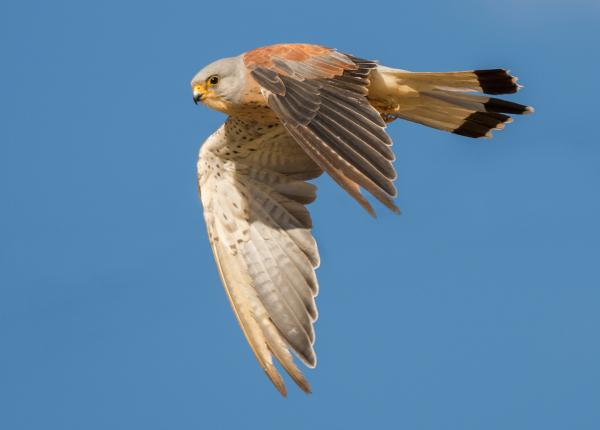Did You Know?
- The Lesser Kestrel sometimes hunts in large flocks, especially around insect swarms
- Even though these kestrels are diurnal, they have been documented hunting insects attracted to artificial lights at night.
How The Peregrine Fund is Helping
Though The Peregrine Fund does not work directly with Lesser Kestrels, our efforts in scientific research, habitat conservation, education, and community development help conserve birds of prey around the world. We also supply literature to researchers from our avian research library, which helps scientists around the world gather and share important information on raptor conservation. Additionally, our support of the Global Raptor Information Network gives raptor researchers tools to more efficiently conduct their own studies while contributing to a global program. It also provides citizen scientists a way to participate in raptor science and conservation.
Where They Live
The Lesser Kestrel has a wide geographic range and is found in parts of Europe, northern Africa, and Asia.Throughout this large range, it makes its home mostly in open areas such as semidesert, steppe landscapes, grasslands, and even agricultural fields. It tends to avoid dense forests.
What They Do
This species is quite gregarious. It can be found in large flocks both during migration and when foraging. In winter, it roosts in tall trees, often in urban areas, together with other falcon species such as the Red-footed and Amur Falcons. Sometimes more than ten thousand of these falcons can all be seen together in these flocks!!
Why They Need Our Help
The Lesser Kestrel has suffered several declines in the past, but its populations have recently recovered in some areas. Though the species is categorized as Least Concern, it still faces many threats including habitat loss due to overgrazing and conversion of lands to agricultural fields, pesticide and rodenticide poisoning, human persecution and the destruction of old buildings which it uses to nest in. Despite these threats, scientists believe this species' population to be stable for the time being.
What They Eat
Like many kestrels, the Lesser Kestrel is a skilled insect hunter and takes large insects including grasshoppers, crickets, and beetles. It will also sometimes feed on birds, reptiles, rodents, fish, and even crabs and earthworms! It employs a few different hunting techniques when in search of a meal. It may hang out on an open perch, including man-made perches such as utility wires and telephone poles, waiting for unsuspecting prey to fly, walk, or slither by. Or, it might pursue its prey on the wing.
Like other kestrels, it might sometimes hover over an open area searching the ground for prey. It is attracted to farm equipment or even cattle that might flush up crickets or other insects, and they can sometimes be seen hunting around grass fires, catching small invertebrates and vertebrates escaping the smoke and flames.
Nests, Eggs, and Young
These falcons breed in small colonies of around 10-20 pairs. Unlike other falcons, they don't build their own nests, but rather lay their eggs in crevices in cliffs, in the walls of old churches, barns, or other buildings, and even in old nests built by other birds, or in nest boxes. It might also be found nesting in what are known as "mixed-species" colonies, where a few different bird species can ef ound nesting close together.
Females will lay between 3-6 eggs, and she and the male both share incubation duties for around 28 days, and in feeding the young after they hatch. However, the male is the one responsible for doing the majority of the hunting during the nesting period. Once the nestlings hatch, they will remain in the nest for around 26-28 days before flying from the nest for the first time.
Lesser Kestrel and the World Center for Birds of Prey
A visit to the World Center for Birds of Prey will provide you with a chance to learn all about different birds of prey. Though we are far away from the Lesser Kestrel's range, our knowledgeable staff is on hand to answer any questions you may have about this, or any other raptor. A visit to our interpretive center is also a great way to learn more about kestrels in general. Examine kestrel feathers at the touch table, and compare the size of a kestrel egg with that of an ostrich. If you walk the interpretive nature trail to the gazebo overlooking the Boise Valley, you are likely to see a kestrel hovering over the sage in search of prey or, if you are lucky, a young bird just learning to fly might be fledging from a nearby nest box. We have an American Kestrel on our Avian Ambassador team, as well. This is a great opportunity to see one of these beautiful birds up close.
References:
BirdLife International. 2021. Falco naumanni. The IUCN Red List of Threatened Species 2021: e.T22696357A205768513. https://dx.doi.org/10.2305/IUCN.UK.2021-3.RLTS.T22696357A205768513.en. Accessed on 22 December 2021.
Global Raptor Information Network. 2021. Species account: Lesser Kestrel Falco naumanni. Downloaded from http://www.globalraptors.org on 22 Dec. 2021
Orta, J. and G. M. Kirwan (2020). Lesser Kestrel (Falco naumanni), version 1.0. In Birds of the World (J. del Hoyo, A. Elliott, J. Sargatal, D. A. Christie, and E. de Juana, Editors). Cornell Lab of Ornithology, Ithaca, NY, USA. https://doi.org/10.2173/bow.leskes1.01










